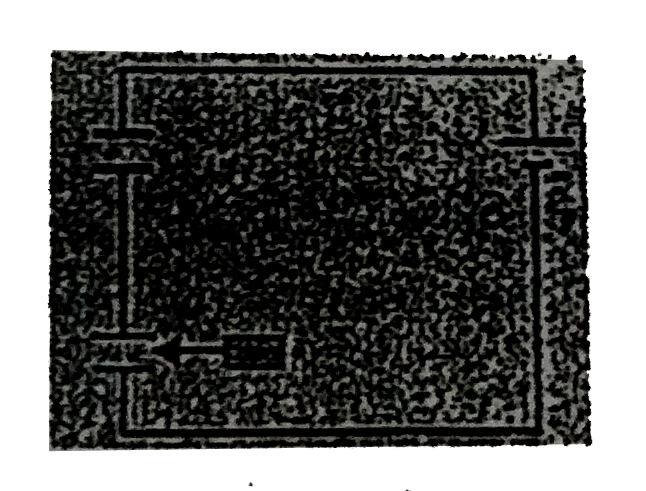Two identical capacitors of 40μF each are connected in series. Now a dielectric slab of dielectric constant K is inserted in one of them such the new equivalent capacitance come out 24μF. Value of k is
2
1
1.5
3
To solve the problem step-by-step, we will analyze the given information about the capacitors and the dielectric slab.
Step 1: Understand the configuration of the capacitors
We have two identical capacitors, each with a capacitance of C1=C2=40μF. They are connected in series. When a dielectric slab with a dielectric constant K is inserted into one of the capacitors, the capacitance of that capacitor changes.
Step 2: Determine the new capacitance after inserting the dielectric
When the dielectric slab is inserted into one of the capacitors, the capacitance of that capacitor becomes:
C′2=K⋅C2=K⋅40μF
Thus, we have:
- C1=40μF
- C′2=K⋅40μF
Step 3: Write the formula for equivalent capacitance in series
For capacitors in series, the equivalent capacitance Ceq is given by:
1Ceq=1C1+1C′2
Substituting the values we have:
1Ceq=140+1K⋅40
Given that Ceq=24μF, we can substitute this into the equation:
124=140+1K⋅40
Step 4: Simplify the equation
To simplify, we can multiply through by 40K:
40K24=K+1
This simplifies to:
5K3=K+1
Step 5: Rearranging the equation
Rearranging gives:
5K3−K=1
This can be rewritten as:
5K−3K3=1
Thus:
2K3=1
Step 6: Solve for K
Multiplying both sides by 3 gives:
2K=3
Dividing by 2 results in:
K=32=1.5
Conclusion
The value of the dielectric constant K is 1.5.
We have two identical capacitors, each with a capacitance of C1=C2=40μF. They are connected in series. When a dielectric slab with a dielectric constant K is inserted into one of the capacitors, the capacitance of that capacitor changes.
When the dielectric slab is inserted into one of the capacitors, the capacitance of that capacitor becomes:
C′2=K⋅C2=K⋅40μF
Thus, we have:
- C1=40μF
- C′2=K⋅40μF
For capacitors in series, the equivalent capacitance Ceq is given by:
1Ceq=1C1+1C′2
Substituting the values we have:
1Ceq=140+1K⋅40
Given that Ceq=24μF, we can substitute this into the equation:
124=140+1K⋅40
To simplify, we can multiply through by 40K:
40K24=K+1
This simplifies to:
5K3=K+1
Rearranging gives:
5K3−K=1
This can be rewritten as:
5K−3K3=1
Thus:
2K3=1
Multiplying both sides by 3 gives:
2K=3
Dividing by 2 results in:
K=32=1.5
The value of the dielectric constant K is 1.5.
Topper's Solved these Questions
Similar Questions
The capacity of a parallel plate air condenser is mμF.If a dielectric of dielectric constant 8 is introduced between the plates,then its new capacity is 24μF. Find the value of m.
View SolutionTwo parallel plate capacitors, each of capacitance 40 muF, are connected is series. The space between the plates of one capacitor is filled with a dielectric material of dielectric constant K =4. Find the equivalent capacitacne of the system.
View Solution
Knowledge Check
Two identical parallel plate capacitors are connected in series to a battery of 100V. A dielectric slab of dielectric constant 4.0 is inserted between the plates of second capacitor. The potential difference across the capacitors will now be respectively
A50V,50VB80V,20VC20V,80VD75V,25VIn a capacitor of capacitance 20μF the distance the plates is 5mm. If a dielectric slab of width 2 dielectric constant 3 is inserted between the plates, new capacitor will be
A22.3μFB25μFC19μFD27.2μFTwo identical capacitors A and B shown in the given circuit are joined in series with a battery. If a dielectric slab of dielectric constant K is slipped between the plates of capacitor B and battery remains connected, then the energy of capacitor A will-
 AdecreasesBincreasesCRemains the sameDBe zero since circuit will not work
AdecreasesBincreasesCRemains the sameDBe zero since circuit will not work
Two identical capacitors are connected as shown in the following figure. If a dielectric slab is inserted in B, choose correct statement

View SolutionTwo identical capacitors are connected in series with a source of constant voltage V. If Q is the charge on one of the capacitors, the capacitance of each capacitor is :
View SolutionThe plates of a parallel plate capacitor with no dielectirc are connected to a volatage source. Now a dielectric of dielectric constant K is inserted to fill the whose space between the plates with voltage source remainign connected to the capacitor-
View SolutionTwo idential parallel plate capacitors are connected in sereis to a cell of 120V. A dielectric slab (K=3) in placed in one of the capacitor. The p.d., across the capacitors will now be
View SolutionTwo identical parallel plate capacitors are connected in series and then joined in series will a batter of 100V. A slab of dielectric constant K=3 is inserted between the plates of the first capacitor. Then, the potential difference across the capacitor will be, respectively.
View Solution
